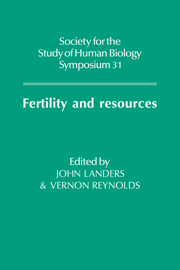Book contents
- Frontmatter
- Contents
- List of contributors
- 1 Introduction
- 2 Environmental and social determinants of fecundity in primates
- 3 Biological aspects of fertility among Third World populations
- 4 A preliminary report on fertility and socio-economic changes in two Papua New Guinea communities
- 5 The cultural context of fertility transition in immigrant Mennonites
- 6 Inter-relationships between consanguinity, religion and fertility in Karnataka, South India
- 7 Resources and the fertility transition in the countryside of England and Wales
- 8 Fertility decline and birth spacing among London Quakers
- 9 Population growth, innovation and resource exploitation
- 10 Fertility decline in developing countries: the roles of economic modernization, culture and Government interventions
- 11 Understanding recent fertility trends in the Third World
- 12 Monogamy, landed property and demographic regimes in pre-industrial Europe: regional contrasts and temporal stabilities
- Index
2 - Environmental and social determinants of fecundity in primates
Published online by Cambridge University Press: 13 March 2010
- Frontmatter
- Contents
- List of contributors
- 1 Introduction
- 2 Environmental and social determinants of fecundity in primates
- 3 Biological aspects of fertility among Third World populations
- 4 A preliminary report on fertility and socio-economic changes in two Papua New Guinea communities
- 5 The cultural context of fertility transition in immigrant Mennonites
- 6 Inter-relationships between consanguinity, religion and fertility in Karnataka, South India
- 7 Resources and the fertility transition in the countryside of England and Wales
- 8 Fertility decline and birth spacing among London Quakers
- 9 Population growth, innovation and resource exploitation
- 10 Fertility decline in developing countries: the roles of economic modernization, culture and Government interventions
- 11 Understanding recent fertility trends in the Third World
- 12 Monogamy, landed property and demographic regimes in pre-industrial Europe: regional contrasts and temporal stabilities
- Index
Summary
During the past decade, detailed data have become available on the life history variables of free-living primates. Although the number of species for which such data are available is still relatively small (and nearly all are Old World monkeys), nonetheless we now know enough to begin to piece together a more coherent picture of the factors that influence fecundity in primates.
Aside from such intrinsic factors as age, two extrinsic factors emerge as important determinants of female fecundity: these are the environmental conditions (principally the availability of food) and the social and demographic circumstances in which an animal finds itself. In this paper, I review the ways in which these factors influence two aspects of female fecundity, namely age at first reproduction and the birth rate itself. I then consider the proximate mechanisms that mediate these effects.
It should be noted that, throughout this paper, I follow biological usage in using the term fecundity to refer to the birth rate. Human demographers conventionally use the term fertility in this context, reserving the term fecundity for the ability to conceive (Cox, 1976). Since reproductive physiologists refer to the ability to conceive as fertility, population biologists have tended to follow suit in order to maintain consistency of usage, and the term fecundity has therefore come to refer to the subsequent occurrence of births (see Ricklefs, 1973; Caughley, 1977; but for an exception, see Wilson & Bossert, 1971).
Determinants of female fecundity
Intrinsic factors
Most studies of wild primates have documented variations in fecundity with age. Following a period of post-menarche juvenile sterility, birth rates increase to reach a peak some two to four years after puberty.
- Type
- Chapter
- Information
- Fertility and Resources , pp. 5 - 17Publisher: Cambridge University PressPrint publication year: 1990
- 4
- Cited by

